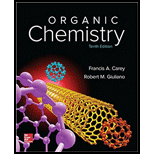
ORGANIC CHEMISTRY-PACKAGE >CUSTOM<
10th Edition
ISBN: 9781260028355
Author: Carey
Publisher: MCG CUSTOM
expand_more
expand_more
format_list_bulleted
Concept explainers
Question
Chapter 17.14, Problem 17P
Interpretation Introduction
Interpretation:
The structure and the stereochemistry along with the description of the configuration of each of the chiral centers present in the given product areto be determined.
Concept Introduction:
>The compounds of the type
They are synthesized by the nucleophilic substitution reactions.
>The reaction between primary or secondary
Expert Solution & Answer
Want to see the full answer?
Check out a sample textbook solution
Students have asked these similar questions
For the titration of a divalent metal ion (M2+) with EDTA, the stoichiometry of the reaction is typically:
1:1 (one mole of EDTA per mole of metal ion)
2:1 (two moles of EDTA per mole of metal ion)
1:2 (one mole of EDTA per two moles of metal ion)
None of the above
Please help me solve this reaction.
Indicate the products obtained by mixing 2,2-dimethylpropanal with acetaldehyde and sodium ethoxide in ethanol.
Chapter 17 Solutions
ORGANIC CHEMISTRY-PACKAGE >CUSTOM<
Ch. 17.1 - Prob. 1PCh. 17.2 - The heats of combustion of 1, 2-epoxybutane...Ch. 17.3 - Prob. 3PCh. 17.4 - Prob. 4PCh. 17.5 - Prob. 5PCh. 17.6 - Problem 17.6 (a) Write equations describing two...Ch. 17.6 - Problem 17.7 Only one combination of alkyl halide...Ch. 17.6 - Prob. 8PCh. 17.8 - Prob. 9PCh. 17.8 - Prob. 10P
Ch. 17.9 - Prob. 11PCh. 17.10 - Problem 17.12 Classify the bromohydrins formed...Ch. 17.11 - Prob. 13PCh. 17.11 - Prob. 14PCh. 17.12 - Prob. 15PCh. 17.12 - Prob. 16PCh. 17.14 - Prob. 17PCh. 17.15 - Prob. 18PCh. 17.16 - Prob. 19PCh. 17.17 - Problem 17.20 There is another oxygen-stabilized...Ch. 17 - Prob. 21PCh. 17 - Many ethers, including diethyl ether, are...Ch. 17 - Although epoxides are always considered to have...Ch. 17 - The name of the parent six-membered...Ch. 17 - Prob. 25PCh. 17 - Prob. 26PCh. 17 - Prob. 27PCh. 17 - Prob. 28PCh. 17 - Prob. 29PCh. 17 - Given that: does the product of the analogous...Ch. 17 - Prob. 31PCh. 17 - Prob. 32PCh. 17 - Prob. 33PCh. 17 - Prob. 34PCh. 17 - Prob. 35PCh. 17 - Prob. 36PCh. 17 - When (R)-(+)-2-phenyl-2-butanol is allowed to...Ch. 17 - Prob. 38PCh. 17 - Prob. 39PCh. 17 - Write a mechanism for the following reaction.Ch. 17 - Prob. 41PCh. 17 - Prob. 42PCh. 17 - Prob. 43PCh. 17 - Prob. 44PCh. 17 - Prob. 45PCh. 17 - Prob. 46DSPCh. 17 - Prob. 47DSPCh. 17 - Prob. 48DSPCh. 17 - Prob. 49DSPCh. 17 - Epoxide Rearrangements and the NIH Shift This...Ch. 17 - Epoxide Rearrangements and the NIH Shift This...
Knowledge Booster
Learn more about
Need a deep-dive on the concept behind this application? Look no further. Learn more about this topic, chemistry and related others by exploring similar questions and additional content below.Similar questions
- Synthesize 2-Ethyl-3-methyloxirane from dimethyl(propyl)sulfonium iodide using the necessary organic or inorganic reagents. Draw the structures of the compounds.arrow_forwardSynthesize 2-Hydroxy-2-phenylacetonitrile from phenylmethanol using the necessary organic or inorganic reagents. Draw the structures of the compounds.arrow_forwardSynthesize N-Methylcyclohexylamine from cyclohexanol using the necessary organic or inorganic reagents. Draw the structures of the compounds.arrow_forward
- Synthesize N-Methylcyclohexylamine from cyclohexanol using the necessary organic or inorganic reagents. Draw the structures of the compounds.arrow_forwardIf possible, please provide the formula of the compound 3,3-dimethylbut-2-enal.arrow_forwardSynthesize 1,4-dibromobenzene from acetanilide (N-phenylacetamide) using the necessary organic or inorganic reagents. Draw the structures of the compounds.arrow_forward
- Indicate the products obtained by mixing (3-oxo-3-phenylpropyl)triphenylphosphonium bromide with sodium hydride.arrow_forwardWe mix N-ethyl-2-hexanamine with excess methyl iodide and followed by heating with aqueous Ag2O. Indicate the major products obtained.arrow_forwardIndicate the products obtained by mixing acetophenone with iodine and NaOH.arrow_forward
- Indicate the products obtained by mixing 2-Propanone and ethyllithium and performing a subsequent acid hydrolysis.arrow_forwardIndicate the products obtained if (E)-2-butenal and 3-oxo-butanenitrile are mixed with sodium ethoxide in ethanol.arrow_forwardQuestion 3 (4 points), Draw a full arrow-pushing mechanism for the following reaction Please draw all structures clearly. Note that this intramolecular cyclization is analogous to the mechanism for halohydrin formation. COH Br + HBr Brarrow_forward
arrow_back_ios
SEE MORE QUESTIONS
arrow_forward_ios
Recommended textbooks for you

 Organic ChemistryChemistryISBN:9781305580350Author:William H. Brown, Brent L. Iverson, Eric Anslyn, Christopher S. FootePublisher:Cengage Learning
Organic ChemistryChemistryISBN:9781305580350Author:William H. Brown, Brent L. Iverson, Eric Anslyn, Christopher S. FootePublisher:Cengage Learning


Organic Chemistry
Chemistry
ISBN:9781305580350
Author:William H. Brown, Brent L. Iverson, Eric Anslyn, Christopher S. Foote
Publisher:Cengage Learning